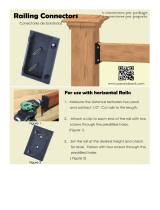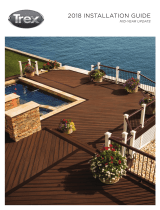Page is loading ...

CABLE RAILING INSTALLATION INSTRUCTIONS
Items you will need:
• Drill/power screwdriver
• Assorted drill bits
• Hammer
• Miter or circular saw
with fine-tooth carbide
tip blade
• Construction adhesive
• Marked speed square
• Two clamps
• Carpenter’s level
• Carpenter’s pencil
• Adjustable wrench or
socket wrench
• Safety glasses/goggles
• Assorted fasteners
(see instructions)
• Tape measure
• Wire cutters
For each 6' or 8' on-center railing section, you will need:
• 1 - 6' or 8' Deckorators top rail from CXT Classic, CXT Pro or
ALX Pro
• 1 - Deckorators post sleeve kit per post (there will be more
posts than railing sections)
• Deckorators stainless steel cable rail (sold on spools of 500')
• Cable hardware: 1 pack per cable, which includes
(2) eye lag screws, (1) fork jaw and (1) turnbuckle
• Cable spacer (sold in packs of 2): 1 per 6 ft section,
2 per 8 ft section
Installation instructions:
Prior to construction, check with your local regulatory agency for
special code requirements in your area. Common railing heights
are 36" and 42". Structural support should come from the con-
tinuation of deck support posts that extend up through the deck
floor or from railing posts that are bolted to the inside of the rim
or outer joists. Never span more than 8’ on-center between rail-
ing posts. Install railing posts before deck boards are fastened
to the joists. Predrilling of all railing components is essential to
successful installation. Do not over-tighten screws. Read instructions
completely to get an understanding of how the product goes
together and how each piece affects the other.
We recommend using a new 5/8" chrome-plated socket to protect
the fittings from raw steel. Avoid installing with rusty tools, as they
leave rust deposits on the surface of the fittings almost immedi-
ately. After installation, it is critical to clean the system completely
with a stainless cleaner and a soft clean rag in order to clear the
surface from carbon deposits.
Step 1: Determine the number of railing posts needed for your
deck. Post spacing is 6' or 8' on-center. Corner applications
(fig. 1a): When taking cable railing through a corner, do not bend
the cable past 45º at any time. When turning 90º, a 2-step turn
using a double corner post configuration is required. Example:
A 12'x16' deck attached to a building with a 4' access opening
on one side, and one 90º corner, will require a total of nine
posts (fig. 1b). Or you can stop your run and start a new one.
Step 2: Install rail posts prior to installing deck boards. Cedar
or pressure-treated pine 4x4 railing posts provide the structural
strength for the railing. The length of each post is determined by
the total of the joist width (7-1/4") + decking thickness (1") + rail-
ing height (36" or 42") + spacing for post cap (1-1/4") = 45-1/2" or
51-1/2". Important: Do not notch the 4x4 railing posts. Notching
will reduce the strength of the post and could result in railing
collapse or failure (fig. 2a).
Step 3: Position, plumb with a level, and clamp the rail post on
the interior face of the joist. Plumb again. The 4x4 railing post
should be bolted to the inside of the joists using two 1/2"x6"
galvanized carriage bolts. Corner posts use a third carriage bolt
inserted through the adjacent joist (fig. 2b).
fig. 1b
fig. 2a
Fig.3.eps
fig. 2b
fig. 3
To End Post
To
End
Post
Cable
CableCorner4.ai
Wood Post
Wood Post with
Composite Sleeve
Post Protector Tubes
•
•
•
•
•
fig. 1a
*Bottom rail optional

©2015 Universal Forest Products, Inc. Deckorators is a registered trademark of Universal Consumer Products, Inc. in the U.S. All rights reserved.
933 US Route 202 Greene, ME 04236-3466 800.880.6278 8548_2/16
Deckorators.com
fig. 4
THIS BROCHURE IS FOR ILLUSTRATION PURPOSES ONLY. USE OF THIS PRODUCT MUST BE IN ACCORDANCE WITH ALL LOCAL ZONING AND/OR BUILDING CODES. CONSUMER ASSUMES ALL
RISKS AND LIABILITY ASSOCIATED WITH THE USE OF THIS PRODUCT. FOR DETAILS ON SAFE HANDLING, GO TO UFPI.COM/PTINFO. WARRANTOR DOES NOT PROVIDE ANY WARRANTY, EITHER
EXPRESS OR IMPLIED, AND SHALL NOT BE LIABLE FOR ANY DAMAGES, INCLUDING CONSEQUENTIAL DAMAGES.
Step 4: Install decking. Notch deck boards to fit around the
4x4 railing posts. Allow 1/4" between the deck boards and
any permanent structure or post. Additional blocking may be
necessary on the 4x4 railing posts for fastening deck boards.
Step 5: Trim 4x4 post sleeves to length if you plan to use a post
cap. Post sleeves should be a minimum of 1-1/2" longer than the
railing height (fig. 3). Example: For a 36" railing, trim post sleeves
to a minimum of 37-1/2", or longer if desired. Slide a trimmed post
sleeve over each 4x4 railing post. Use shims as needed to create
a snug fit. Slide a post base trim over each post sleeve.
Step 6: Find the center of your post sleeve and clamp the cable
spacer in place. This will be your template for predrilling holes
for cables. Predrill holes using a 3/16" drill bit (fig. 4). Note: When
running a cable through the post, drilling halfway through one
side of the post and then remeasuring and drilling through the
other side will result in a much easier, cleaner finish. You can also
make a template by using a 2x4 and aligning it to your post sleeve.
Step 7: Refer to specific instructions included in the railing kit to
install the top rail to your post. Use the included connectors to
assemble the cable spacer(s) to the top rail. Line up the connector
with the center of your rail for 6' applications and mark for
positioning. Position cable spacer on deck and fasten with
included screws. Note: Use one cable spacer per 6' section
and two per 8' section (1 spacer every 2.5 ft for 8').
Step 8: Install eye lag screws into the predrilled post sleeve
holes on both ends of rail (fig. 5). Tip: Use a 5/8" socket and
drill to install eye lags into post.
Step 9: Remove the pinch pin from the fork jaw and turnbuckle
and install into eye lag screws. Note: Install all fork jaws on one
end of rail and all turnbuckles on other end.
Step 10: Open turn buckle all the way before installing cables.
Step 11: To install cable, start at the turnbuckle location and feed
cable through cable spacers/posts to fork jaw location. To install
cable into fork jaw or turnbuckle, slide jaw housing onto one end
of the cable. Slide the jaws onto the cable. Place the brass pressure
ring onto the cable 5 mm from the end. Slide the jaw housing
down over the jaws (fig. 6). Tighten the lock nut firmly to the jaw
housing. Run cable through cable spacer(s)/post.
Step 12: Repeat step 10 on opposing side of cable to create tension.
NOTE: Install all cable before tightening.
Step 13: To tighten cable, start at the center point and alternate
between tightening top and bottom cables by inserting a screwdriver
in the turnbuckle and turning to create tension. Use a wrench to hold
cable in place so it doesn't turn along with turnbuckle. To finish,
tighten nut from each side of turnbuckle. Tip: Use two wrenches
(#10 and #12) to hold nut and jaw assembly to tighten.
CABLE RAILING INSTALLATION INSTRUCTIONS
C
L
Step10.ai
Step11.ai
Jaw Housing
Jaw
5mm
Cable
Brass Ring
•
•
•
•
•
•
Spacer
Post
•
•
Clamp
Step6b.ai
•
fig. 5
fig. 6
1
2
3
5
7
10
CableAdj.ai
4
6
8
9
/





